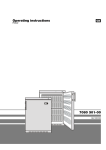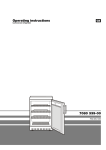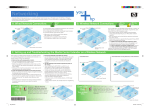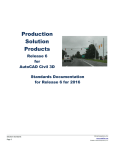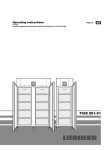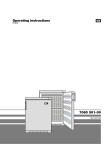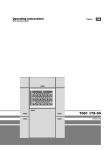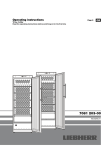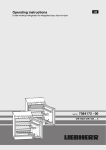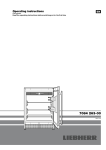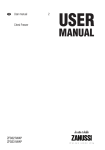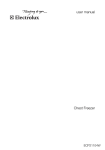Download Operating instructions
Transcript
Operating instructions Freezer Page 4 GB 7080 579-02 UTSD 1106 Disposal notes The packaging is made of recyclable materials. - Corrugated board/board EPS moulded parts Polythene sheets Polypropylene straps • Keep packaging materials away from children - polythene sheets and bags can cause suffocation! • Please return the packaging to an official collection point. Your old appliance: This contains some reusable materials and should be disposed of properly - not simply with unsorted household refuse. • Discarded appliances should be disabled: Remove the plug, cut through the connection cable and render the catch unusable so that children cannot become trapped inside. • Ensure that the refrigerant circuit is not damaged when the appliance that is no longer needed is taken away for disposal. • Details of the refrigerant can be found on the type plate. • Appliances which are no longer needed must be disposed of in a professional and appropriate way, in accordance with the current local regulations and laws. Safety instructions and warnings • To prevent injury or damage to the unit, the appliance should be unpacked and set up by two people. • In the event that the appliance is damaged on delivery, contact the supplier immediately before connecting to the mains. • To guarantee safe operation, ensure that the appliance is set up and connected as described in these operating instructions. • Disconnect the appliance from the mains if any fault occurs. Pull out the plug, switch off or remove the fuse. • When disconnecting the appliance, pull on the plug, not on the cable. • Any repairs and work on the appliance should only be carried out by the customer service department, as unauthorised work could prove highly dangerous for the user. The same applies to changing the mains power cable. • Do not allow naked flames or ignition sources to enter the appliance. When transporting and cleaning the appliance ensure that the refrigerant circuit is not damaged. In the event of damage, make sure that there are no ignition sources nearby and keep the room well ventilated. • Do not stand on the plinth, drawers or doors or use them to support anything else. • This appliance is not intended for use by persons (including children) with reduced physical, sensory or mental capabilities or lack of experience and knowledge unless they have been given initial supervision or instruction concerning use of the appliance by a person responsible for their safety. Children should be supervised to ensure that they do not play with the appliance. • Avoid prolonged skin contact with cold surfaces or chilled/frozen food. This could cause pain, numbness and frostbite. In the case of prolonged skin contact, protective measures should be taken, e.g. gloves should be worn. • Do not eat ice cream, particulary ice lollies or ice cubes, immediately after taking them from the freezer compartment as there is a risk of "burning" because of the very cold temperatures. • Do not consume food which has been stored for too long, as it could cause food poisoning. • Do not store explosives or sprays using combustible propellants such as butane, propane, pentane etc. in the appliance. Electrical components might cause leaking gas to ignite. You may identify such sprays by the printed contents or a flame symbol. • Do not use electrical appliances inside the appliance. • If you have a lockable appliance, do not keep the key near the appliance or within reach of children. Setting up • Avoid positioning the appliance in direct sunlight or near cookers, radiators and similar sources of heat. • The floor on which the appliance stands should be horizontal and level.Compensate for uneven floors with the adjustable feet. • There must be a gap of at least 20 cm between the upper edge of the appliance and the ceiling. Always ensure that there is good ventilation and that the outward flowing air is able to escape. • In order to be able to slide the appliance into a recess, it is fitted with castors at the rear. These castors are not suitable for transportation nor for moving the appliance across uneven floors or steps. • Standard EN 378 specifies that the room in which you install your appliance must have a volume of 1 m3 per 8 g of R 600a refrigerant used in the appliance, so as to avoid the formation of inflammable gas/air mixtures in the room where the appliance is located in the event of a leak in the refrigerant circuit. The quantity of refrigerant used in your appliance is indicated on the type plate on the inside of the appliance. • Do not connect the appliance to the supply with other equipment using an extension cable - risk of overheating. Climate rating The appliance is set to operate within specific ambient temperature limits according to its climate rating. These temperature limits should not be exceeded. The correct climate rating for your appliance is indicated on the type plate. Climate rating SN N ST T Ambient temperatures + 10° to + 32 °C + 16° to + 32 °C + 18° to + 38 °C + 18° to + 43 °C Dimensions Height: 1860 mm Width: 600 mm Depth: 650 mm Connecting to the mains Power supply (a.c.) and voltage at the operating point must comply with the details on the type plate, which is located in the freezer compartment on the right-hand side. The socket must be fused with a 10 A fuse or higher, it must be away from the rear of the appliance and must be easily accessible. Connect the appliance with a properly earthed fused plug and socket only. Switching the appliance on and off You are recommended to clean the appliance before switching it on for the first time (see "Cleaning"). Switch the appliance on 4 hours before loading it with frozen food for the first time. To switch the appliance on: Connect the appliance to the mains - the appliance is switched on. To switch the appliance off: Pull out the mains plug or set the temperature T control to "•". Setting the temperature Using a coin, turn the arrow on the temperature control T to a setting between "1" und "7". Setting "1" = lowest cooling setting, warm Setting "7" = highest cooling setting, cold For long-term storage of frozen food a temperature of at least -18°C is recommended. 4 GB Storage Cleaning The appliance is suitable for storing ice cream and ready-frozen foods. Before cleaning always switch off the appliance. Pull out the mains plug or remove/unscrew the fuse. The grid shelves can be moved to accommodate different height bottles or packages. To remove the shelves the door must be opened wider than 90°. Clean the inside, equipment parts and outer walls with lukewarm water and a little detergent. Do not use abrasive or acid cleaners or chemical solvents. Temperature display Do not use steam cleaners because of the risk of injury and damage. The thermometer shows the warmest frozen food temperature. It is adjusted and designed so that only temperatures below 0°C are accurately displayed. Interior light The interior light is fitted on the inside at the top. It can be switched on and off by pressing the switch S. To change the tube: Pull out the mains plug or remove/ unscrew the fuse. - Lever out the cover panel on the lamp housing and remove downwards. - Change the fluorescent tube. - Replace the cover panel. If the interior light still does not work after you have changed the bulb, please consult your nearest customer service point. • Ensure that no cleaning water penetrates into the electrical components or ventilation grille. • Dry all parts well with a cloth. • The dust should be removed from the refrigeration unit and heat exchanger – metal grid at the back of the appliance – once a year. • Do not damage or remove the type plate on the inside of the appliance. It is very important for servicing purposes. Cleaning the dust filter Deposits of grease and dust can stop the appliance from working properly and can increase operating costs. The filter should therefore be cleaned when it gets dirty. Remove the dust from the filter and then wash it with water and detergent. Disconnect the plug or remove the fuse. • Open door and pull filter on the left hand side out at the top. • Slide filter to the left and remove. • Replace in reverse order. Malfunctions You may be able to rectify the following faults by checking the possible causes yourself: Display light: The light in the display housing at the front and top of the appliance also consists of a fluorescent tube. This is switched in series with the interior lamp, so that all the lighting will fail if one of the tubes is defective. To change the fluorescent tube in the display: Pull out the mains plug or remove/unscrew the fuse. To remove the defective lamp, undo the screws on the top of the appliance and slide the display housing upwards. Appliance does not function: – Is the appliance switched on? – Is the plug correctly fitted in the mains socket? – Is the socket fuse intact? The temperature is not low enough: – Is the temperature setting correct (see "Setting the temperature")? – Have excessive amounts of fresh food been placed in the appliance? Observe the temperature display for a further 24 hours. – Does the separately installed thermometer show the correct reading? – Is the ventilation system working properly? – Is the appliance set up too close to a heat source? If none of the above causes apply and you cannot rectify the fault yourself, contact the nearest customer service department stating the type of appliance ➊, index ➋ and appliance number ➌ as indicated on the type plate. The type plate is located in the freezer compartment on the right-hand side. Shutting your appliance down Defrosting The No-frost system automatically defrosts the appliance. Ani moisture arising collects on the evaporator and freezes, and is periodically defrosted and evaporated. If your appliance is to be shut down for any length of time, switch it off and disconnect the plug or remove the fuse. Clean the appliance and leave the door open in order to prevent unpleasant smells. The refrigerant circuit has been tested for leaks. The appliance is radio-suppressed to EN 55014 and thus complies with EC Directive 87/308/EEC. 5



